Foam rolling used to be a mysterious, “experimental” technique used solely by professional athletes, coaches, and therapists, its ultimate effectiveness unproven.
Well, thanks to years of technique development, and a bit of recent clinical research, foam rolling has become a common practice for people at all levels of fitness, and for good reason.
For just $20 – 40 and 5 – 10 minutes of your time, a few days per week, you can use foam rolling to dramatically improve mobility and thus range of motion, to reduce the risk of injury, and to remove pains that you might be experiencing while you put your body through certain motions.
In this article, I want to explain a bit of why foam rolling works, and 5 of my favorite foam rolling exercises for supporting my weightlifting routine.
Table of Contents
+
How Foam Rolling Works
In fancy-speak, foam rolling is a “self-myofascial release” method that relaxes overactive muscles that are preventing proper activation and motion.
To understand self-myofascial release, let’s break it down:
Myo- is a prefix meaning “muscle,” and fascia is a soft, fibrous tissue that surrounds muscles, blood vessels, and nerves, allowing for mobility while providing support and protection.
Thus, self-myofascial release simply refers to a way whereby you can release tension in the fascia surrounding your muscles, and the muscles themselves.
You see, fascia can become overly tight through overuse, injury, and even inactivity. The result is inflammation, pain, muscle tension, reduction of blood flow, and loss of mobility, and if the problem becomes severe or prolonged, the fascia can actually thicken, causing pain and further inflammation.
Now, mechanically speaking, foam rolling is very simple.
You position your body in certain ways on a foam cylindrical tube to put pressure on trigger points, which are tight spots in muscles that, when pressed on, produce pain that refers to other areas in the body (can be felt in areas other than where you’re applying pressure) .
By holding pressure on these trigger points, your body will gradually relax the areas, causing the pain to fade. This is known as releasing trigger points.
“Relaxation” is underselling the benefits of foam rolling, though. It can actually make quite a difference in your training.
The Benefits of Foam Roller Exercises
When you release fascial and muscular tightness, inflammation and pain diminish, and blood flow is restored.
While this might “sound nice,” it actually means a lot for us fitness folk.
For example, a study conducted by Memorial University of Newfoundland found that foam rolling increases range of motion without decreasing strength (which is a problem with pre-workout stretching).
The greater the range of motion in an exercise, the more work your muscles have to do, which in turn leads to great gains in strength and size. And due to the fact that it doesn’t impair performance, you can foam roll before a workout to prime your body for the training.
A study conducted by Osaka Aoyama University found that foam rolling reduces arterial stiffness and thus improves blood flow.
Better blood flow means better removal of metabolic waste from tissues and better delivery of nutrients, which ultimately helps with muscle repair.
We can see these effects in a study that demonstrated that foam rolling reduces the severity of delayed-onset muscle soreness (DOMS) that occurs after training, and increases range of motion.
So, as you can see, regular foam rolling over longer periods of time can actually make quite a difference in the results you get out of your training.
My 5 Favorite Foam Roller Exercises
There are a wide variety of foam roller exercises that you can do, but here are my top 5.
You can perform these exercise pre-workout to improve performance, or post-workout to improve recovery, or both.
In terms of time, I like to spend a couple minutes on each, finding and releasing 1 – 2 trigger points for each muscle group.
Iliotibial Tract (IT Band) Foam Roller Exercise
The “IT Band” runs along the outer side of your leg, and its associated muscles are involved in various hip movements, and the stabilization of the knees.
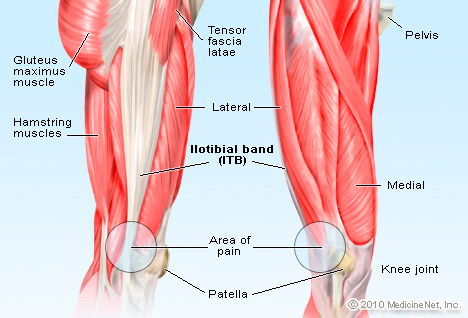
Regular proper squatting will often create trigger points in the IT Band, which in turn impair range of motion and performance.
Here’s how to foam roll the IT Band:
Hamstring Foam Roller Exercise
Tight hamstrings are a curse for squatting and deadlifting, and foam rolling can really help.
Here’s how to do it:
Quadriceps Foam Roller Exercise
Trigger points in the quadriceps can insidiously affect your squatting.
I had this problem recently and the affected quadriceps couldn’t contract properly, which transferred more of the load to the various smaller stabilizing muscles in my hip. This caused excessive soreness in my hip muscles, which kept me from being able to progress.
Use the following foam roller exercise to avoid this problem:
Rhomboids Foam Roller Exercise
The rhomboids (major and minor) are back muscles that connect your shoulder blades with your spine, and are activated to retract the shoulder blades.
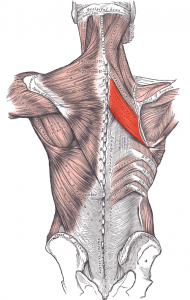
The rhomboids not only get hit hard when we train back, they can get quite stiff from sitting all day (especially with bad posture).
The following rhomboid foam roller exercise is a great way to release tension in these muscles:
Latissimus Dorsi Foam Roller Exercise
You probably know the latissimus dorsi, or “lat,” but here it is in case you don’t:
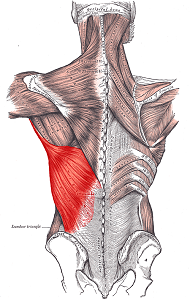
This is another muscle primarily targeted in back training, and thus it often develops trigger points.
Here’s the foam roller exercise for it:
Buying a Foam Roller
A good foam roller is moderately dense–if the foam is too soft, you can’t apply enough pressure; if it’s too hard, you can wind up bruising yourself, causing too much trauma to the trigger point areas.
Here are the two foam rollers I like and recommend:
High-Density Foam Roller
A good high-density foam roller is cheap and gets the job done. Can’t go wrong.
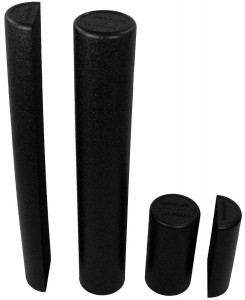
Rumble Roller
 The Rumble Roller products are another great option.
The Rumble Roller products are another great option.
Although a Rumble Roller is more expensive than the simple high-density roller, I like it quite a bit more. It’s more forgiving (the harder the roller, the less pressure you can apply before it begins to really hurt) and the knobs are great for working out tight spots.
I like the original density (blue) best.
Trigger Point Performance “The Grid” Foam Roller
What I like about this fancy-looking foam roller is the different surfaces of the grid layout let you apply different amounts and types of pressure on trigger points, which can sometimes be tricky to find and target for release.
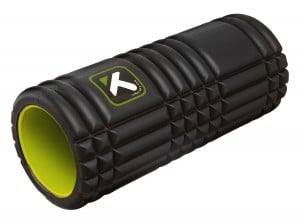
What did you think of this article? Have anything else you’d like to share? Let me know in the comments below!
Scientific References +
- MacDonald GZ, Button DC, Drinkwater EJ, Behm DG. Foam Rolling as a Recovery Tool after an Intense Bout of Physical Activity. Med Sci Sport Exerc. 2014;46(1):131-142. doi:10.1249/MSS.0b013e3182a123db
- Okamoto T, Masuhara M, Ikuta K. Acute effects of self-myofascial release using a foam roller on arterial function. J Strength Cond Res. 2014;28(1):69-73. doi:10.1519/JSC.0b013e31829480f5
- Sullivan KM, Silvey DBJ, Button DC, Behm DG. Roller-massager application to the hamstrings increases sit-and-reach range of motion within five to ten seconds without performance impairments. Int J Sports Phys Ther. 2013;8(3):228-236. http://www.ncbi.nlm.nih.gov/pubmed/23772339. Accessed February 5, 2020.
- Pinto RS, Gomes N, Radaelli R, Botton CE, Brown LE, Bottaro M. Effect of range of motion on muscle strength and thickness. J Strength Cond Res. 2012;26(8):2140-2145. doi:10.1519/JSC.0b013e31823a3b15
- MacDonald GZ, Penney MDH, Mullaley ME, et al. An acute bout of self-myofascial release increases range of motion without a subsequent decrease in muscle activation or force. J Strength Cond Res. 2013;27(3):812-821. doi:10.1519/JSC.0b013e31825c2bc1
- Findley T, Chaudhry H, Stecco A, Roman M. Fascia research - A narrative review. J Bodyw Mov Ther. 2012;16(1):67-75. doi:10.1016/j.jbmt.2011.09.004
- Miernik M, Wiȩckiewicz M, Paradowska A, Wiȩckiewicz W. Massage therapy in myofascial TMD pain management. Adv Clin Exp Med. 2012;21(5):681-685. https://www.ncbi.nlm.nih.gov/pubmed/23356206. Accessed February 5, 2020.
- Schleip R. Fascial plasticity - A new neurobiological explanation: Part 1. J Bodyw Mov Ther. 2003;7(1):11-19. doi:10.1016/S1360-8592(02)00067-0
- Langevin HM, Stevens-Tuttle D, Fox JR, et al. Ultrasound evidence of altered lumbar connective tissue structure in human subjects with chronic low back pain. BMC Musculoskelet Disord. 2009;10(1). doi:10.1186/1471-2474-10-151










